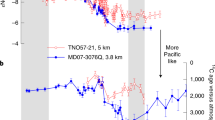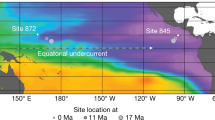Abstract
Ocean circulation is closely linked to climate change on glacial–interglacial and shorter timescales. Extensive reorganizations in the circulation of deep and intermediate-depth waters in the Atlantic Ocean have been hypothesized for both the last glaciation1,2,3,4,5,6 and the subsequent Younger Dryas cold interval3,6,7,8,9,10, but there has been little palaeoceanographic study of the subtropical gyres11,12,13. These gyres are the dominant oceanic features of wind-driven circulation, and as such they reflect changes in climate and are a significant control on nutrient cycling and, possibly, atmospheric CO2 concentrations. Here we present Cd/Ca ratios in the shells of benthic foraminifera from the Bahama banks that confirm previous suggestions11,12 that nutrient concentrations in the North Atlantic subtropical gyre were much lower during the Last Glacial Maximum than they are today (up to 50% lower according to our data). These contrasting nutrient burdens imply much shorter residence times for waters within the thermocline of the Last Glacial Maximum. Below the glacial thermocline, nutrient concentrations were reduced owing to the presence of Glacial North Atlantic Intermediate Water. A high-resolution Cd/Ca record from an intermediate depth indicates decreased nutrient concentrations during the Younger Dryas interval as well, mirroring opposite changes at a nearby deep site3,9. Together, these observations suggest that the formation of deep and intermediate waters — North Atlantic Deep Water and Glacial North Atlantic Intermediate Water, respectively — wax and wane alternately on both orbital and millennial timescales.
This is a preview of subscription content, access via your institution
Access options
Subscribe to this journal
Receive 51 print issues and online access
$199.00 per year
only $3.90 per issue
Buy this article
- Purchase on Springer Link
- Instant access to full article PDF
Prices may be subject to local taxes which are calculated during checkout




Similar content being viewed by others
References
Boyle, E. A. & Keigwin, L. D. Deep circulation of the North Atlantic over the last 200,000 years: Geochemical evidence. Science 218, 784–787 (1982).
Curry, W. B. & Lohmann, G. P. Reduced advection into Atlantic Ocean deep eastern basins during last glaciation maximum. Nature 306, 577–580 (1983).
Boyle, E. A. & Keigwin, L. D. North Atlantic thermohaline circulation during the past 20,000 years linked to high-latitude surface temperature. Nature 330, 35–40 (1987).
Curry, W. B., Duplessy, J. C., Labeyrie, L. D. & Shackleton, N. J. Changes in the distribution of δ13C of deep water ΣCO2between the last glaciation and the Holocene. Paleoceanography 3, 317–341 (1988).
Duplessy, J. C.et al. Deepwater source variations during the last climatic cycle and their impact on the global deepwater circulation. Paleoceanography 3, 343–360 (1988).
Sarnthein, M.et al. Changes in east Atlantic deepwater circulation over the last 30,000 years: Eight time slice reconstructions. Paleoceanography 9, 209–267 (1994).
Broecker, W. S., Peteet, D. M. & Rind, D. Does the ocean-atmosphere system have more than one stable mode of operation? Nature 315, 21–25 (1985).
Broecker, W. S.et al. The chronology of the last deglaciation: Implications to the cause of the Younger Dryas event. Paleoceanography 3, 1–19 (1988).
Keigwin, L. D., Jones, G. A., Lehman, S. J. & Boyle, E. A. Deglacial meltwater discharge, North Atlantic deep circulation, and abrupt climate change. J. Geophys. Res. 96, 16811–16826 (1991).
Smith, J. E., Risk, M. J., Schwarz, H. P. & McConnaughey, T. A. Rapid climate change in the North Atlantic during the Younger Dryas recorded by deep-sea corals. Nature 386, 818–820 (1997).
Slowey, N. C. & Curry, W. B. Enhanced ventilation of the North Atlantic subtropical gyre thermocline during the last glaciation. Nature 358, 665–668 (1992).
Slowey, N. C. & Curry, W. B. Glacial-interglacial differences in circulation and carbon cycling within the upper western North Atlantic. Paleoceanography 10, 715–732 (1995).
Haddad, G. A. & Droxler, A. W. Metastable CaCO3dissolution at intermediate water depths of the Caribbean and western North Atlantic: Implications for intermediate water circulation during the past 200,000 years. Paleoceanography 11, 701–716 (1996).
Pedlosky, J. The dynamics of the oceanic subtropical gyres. Science 248, 316–322 (1990).
Olson, D. B., Schott, F. A., Zantopp, R. J. & Leaman, K. D. The mean circulation east of the Bahamas as determined from a recent measurement program and historical XBT data. J. Phys. Oceanogr. 14, 1470–1487 (1984).
Boyle, E. A. Cadmium: Chemical tracer of deepwater paleoceanography. Paleoceanography 3, 471–489 (1988).
Hester, K. & Boyle, E. A. Water chemistry control of the Cd content of benthic foraminifera. Nature 298, 260–261 (1982).
Boyle, E. A., Labeyrie, L. & Duplessy, J. C. Calcitic foraminiferal data confirmed by cadmium in aragonitic Hoeglundina: Application to the last glacial maximum in the northern Indian Ocean. Paleoceanography 10, 881–900 (1995).
Charles, C. D., Wright, J. D. & Fairbanks, R. G. Thermodynamic influences on the marine carbon isotope record. Paleoceanography 8, 691–697 (1993).
Boyle, E. A. Cadmium and δ13C paleochemical ocean distributions during the Stage 2 glacial maximum. Annu. Rev. Earth Planet. Sci. 20, 245–287 (1992).
Fairbanks, R. G. A17,000-year glacio-eustatic sea level record: influence of glacial melting rates on the Younger Dryas event and deep-ocean circulation. Nature 342, 637–642 (1989).
Zahn, R. & Keir, R. in Carbon Cycling in the Glacial Ocean: Constraints on the Ocean's Role in Global Change (eds Zahn, R. et al.) 195–221 (NATO ASI Ser. Vol. I 17, Berlin, (1994).
Wüst, G. On the stratification and the circulation in the cold water sphere of the Antillean-Caribbean basins. Deep-Sea Res. 10, 165–187 (1963).
CLIMAP Project Members. The surface of the ice-age Earth. Science 191, 1131–1137 (1976).
Boyle, E. A. The role of vertical chemical fractionation in controlling Late Quaternary atmospheric carbon dioxide. J. Geophys. Res. 93, 15701–15714 (1988).
Zahn, R. et al. Thermohaline instability in the North Atlantic during meltwater events: Stable isotope and ice-rafted detritus records from core SO75-26KL, Portuguese margin. Paleoceanography 12, 696–710 (1997).
Lynch-Stieglitz, J., van Geen, A. & Fairbanks, R. G. Interocean exchange of Glacial North Atlantic Intermediate Water: Evidence from Subantarctic Cd/Ca and carbon isotope measurements. Paleoceanography 11, 191–201 (1996).
Dickson, R., Lazier, J., Meincke, J., Rhines, P. & Swift, J. Long-term coordinated changes in the convective activity of the North Atlantic. Prog. Oceanogr. 38, 241–295 (1996).
Hughen, K. A.et al. Deglacial changes in oceanic circulation from an extended radiocarbon calibration. Nature 391, 65–68 (1998).
Rahmstorf, S. Rapid climate transitions in a coupled ocean-atmosphere model. Nature 372, 82–85 (1994).
Acknowledgements
We thank P. Lohmann for providing modern Bahamas PO43− data and sediment grabsamples; M. Jeglinski, D. Ostermann and L. Zou for isotope laboratory assistance; and E. Boyle, L.Keigwin, L. Labeyrie, D. McCorkle, J. McManus and R. Zahn for comments and discussions. This work was supported by the US NSF.
Author information
Authors and Affiliations
Corresponding author
Supplementary Information
Rights and permissions
About this article
Cite this article
Marchitto, T., Curry, W. & Oppo, D. Millennial-scale changes in North Atlantic circulation since the last glaciation. Nature 393, 557–561 (1998). https://doi.org/10.1038/31197
Received:
Accepted:
Issue Date:
DOI: https://doi.org/10.1038/31197
This article is cited by
-
Consistently dated Atlantic sediment cores over the last 40 thousand years
Scientific Data (2019)
-
Evolution of the deep Atlantic water masses since the last glacial maximum based on a transient run of NCAR-CCSM3
Climate Dynamics (2016)
-
Changes in North Atlantic nitrogen fixation controlled by ocean circulation
Nature (2013)
-
Abrupt changes in Antarctic Intermediate Water circulation over the past 25,000 years
Nature Geoscience (2008)
-
Ice core evidence for secular variability and 200-year dipolar oscillations in atmospheric circulation over East Antarctica during the Holocene
Climate Dynamics (2005)
Comments
By submitting a comment you agree to abide by our Terms and Community Guidelines. If you find something abusive or that does not comply with our terms or guidelines please flag it as inappropriate.



